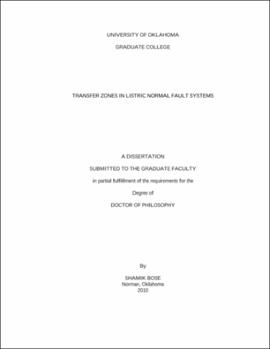| dc.contributor.advisor | Mitra, Shankar | |
| dc.creator | Bose, Shamik | |
| dc.date.accessioned | 2019-04-27T21:30:29Z | |
| dc.date.available | 2019-04-27T21:30:29Z | |
| dc.date.issued | 2010 | |
| dc.identifier | 99249941502042 | |
| dc.identifier.uri | https://hdl.handle.net/11244/318852 | |
| dc.description.abstract | Listric normal faults are common in passive margin settings where sedimentary units are detached above weaker lithological units, such as evaporites or are driven by basal structural and stratigraphic discontinuities. The geometries and styles of faulting vary with the types of detachment and form landward and basinward dipping fault systems. Complex transfer zones therefore develop along the terminations of adjacent faults where deformation is accommodated by secondary faults, often below seismic resolution. The rollover geometry and secondary faults within the hanging wall of the major faults also vary with the styles of faulting and contribute to the complexity of the transfer zones. This study tries to understand the controlling factors for the formation of the different styles of listric normal faults and the different transfer zones formed within them, by using analog clay experimental models. Detailed analyses with respect to fault orientation, density and connectivity have been performed on the experiments in order to gather insights on the structural controls and the resulting geometries. A new high resolution 3D laser scanning technology has been introduced to scan the surfaces of the clay experiments for accurate measurements and 3D visualizations. Numerous examples from the Gulf of Mexico have been included to demonstrate and geometrically compare the observations in experiments and real structures. A salt cored convergent transfer zone from the South Timbalier Block 54, offshore Louisiana has been analyzed in detail to understand the evolutionary history of the region, which helps in deciphering the kinematic growth of similar structures in the Gulf of Mexico. The dissertation is divided into three chapters, written in a journal article format, that deal with three different aspects in understanding the listric normal fault systems and the transfer zones so formed. | |
| dc.description.abstract | The first chapter involves clay experimental models to understand the fault patterns in divergent and convergent transfer zones. Flat base plate setups have been used to build different configurations that would lead to approaching, normal offset and overlapping faults geometries. The results have been analyzed with respect to fault orientation, density, connectivity and 3D geometry from photographs taken from the three free surfaces and laser scans of the top surface of the clay cake respectively. | |
| dc.description.abstract | The second chapter looks into the 3D structural analysis of the South Timbalier Block 54, offshore Louisiana in the Gulf of Mexico with the help of a 3D seismic dataset and associated well tops and velocity data donated by ExxonMobil Corporation. This study involves seismic interpretation techniques, velocity modeling, cross section restoration of a series of seismic lines and 3D subsurface modeling using depth converted seismic horizons, well tops and balanced cross sections. | |
| dc.description.abstract | The third chapter deals with the clay experiments of listric normal fault systems and tries to understand the controls on geometries of fault systems with and without a ductile substrate. Sloping flat base plate setups have been used and silicone fluid underlain below the clay cake has been considered as an analog for salt. The experimental configurations have been varied with respect to three factors viz. the direction of slope with respect to extension, the termination of silicone polymer with respect to the basal discontinuities and overlap of the base plates. The analyses for the experiments have again been performed from photographs and 3D laser scans of the clay surface. | |
| dc.format.extent | 180 pages | |
| dc.format.medium | application.pdf | |
| dc.language | en_US | |
| dc.relation.requires | Adobe Acrobat Reader | |
| dc.subject | Faults (Geology)--Mexico, Gulf of | |
| dc.subject | Seismic prospecting--Mexico, Gulf of | |
| dc.subject | Geology, Structural--Mexico, Gulf of | |
| dc.title | Transfer Zones in Listric Normal Fault Systems | |
| dc.type | text | |
| dc.type | document | |
| dc.thesis.degree | Ph.D. | |
| ou.group | Mewbourne College of Earth and Energy::ConocoPhillips School of Geology and Geophysics | |
